Urban Spectacle
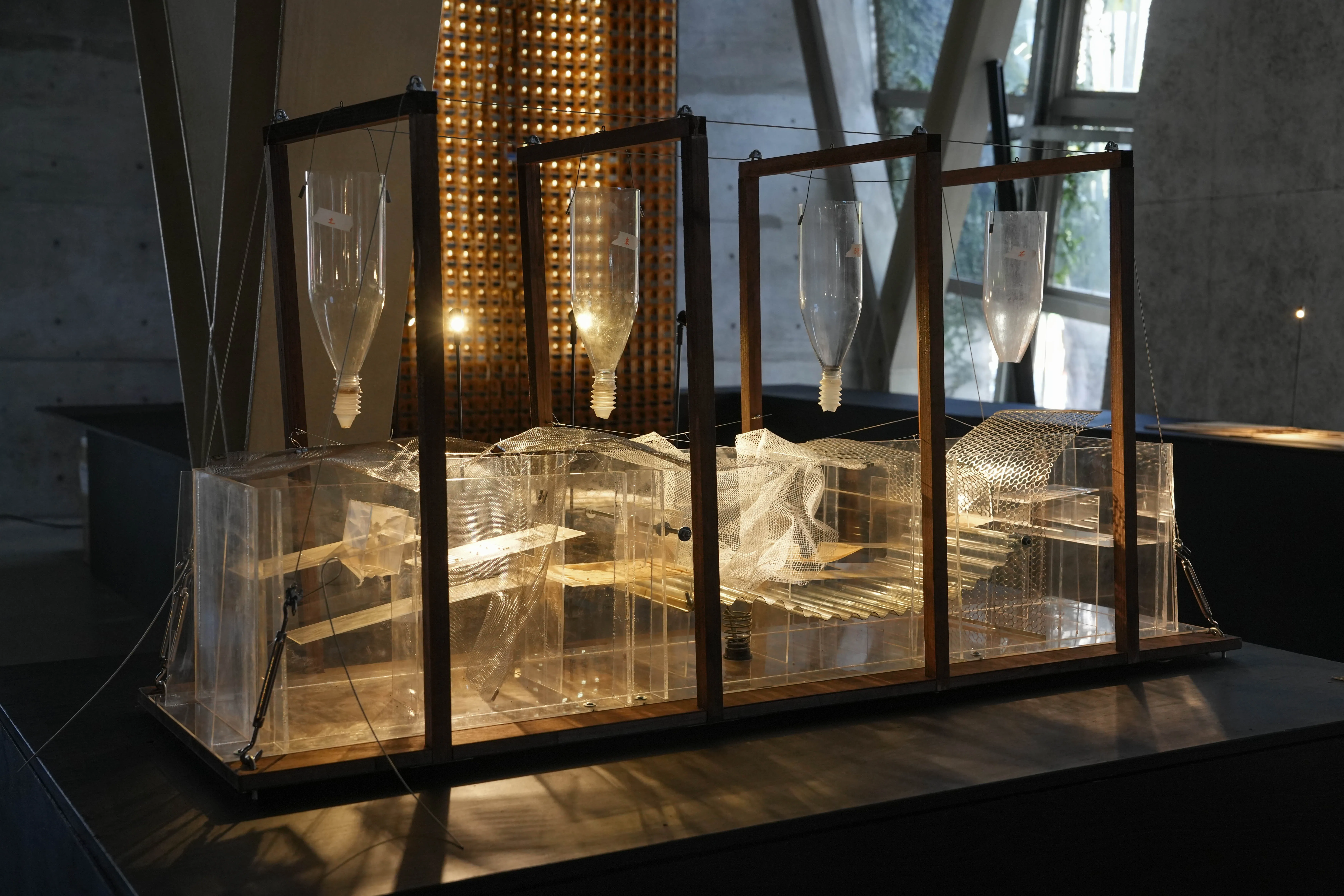
#flâneur
#détournement
#spectacle
#Gameboard
#Dynamic Map
Exhibitor
Wei TSENG,
Jeong-Der HO
Exhibition Team
Tunghai University Department of Architecture
Team Member
Yu-En HUANG,
Hsuan Ting CHEN,
Li HSU,
Yi-Hsin CHEN,
Li-Hsuan LIN,
Ya-Wen YANG,
You-Chen CHUANG,
Pony WU,
Chen-Wei LIN,
Yuan-Chee LEE
View the Printed Edition (PDF)
Urban Negotiation Practice
In a fictional urban layout, construct textures and objects, using it as a playground for game operations. Ten urban relationships intertwine within it, overwriting, stitching, filling, connecting,stabilizing and destabilizing, spreading… On the map, try to build the complexity of the city and possible opportunities for extension through a process of discussion and coordination. This approach serves as the first step in intervening in the city and imagining the city.

Time Slide Map
We defined the gameboard boundaries to align with Ximending’s official area, designated by the government as Zhonghua Road, Chengdu Road, Hankou Street, and Kangding Road. Onsite,we observed active systems disrupting these predefined boundaries and established symbolic rules to organize them.
Through temporal slices—weekdays, weekends,evenings, and early mornings—we found Ximending’s activities vary in density. In the evening, crowds converge in the pedestrian zone,while in the early morning, they scatter like isolated islands. Ximending is a patchwork of cultures and communities, where external elements—people,food, and waste—enter, linger, and depart. Certain groups form and disperse in patterns reminiscent of specific beliefs, prompting us to question its established boundaries.
To further analyze this complex space, we examined it through five dimensions: Belief, Ecology, Cuisine,Recreation, and Alternative.
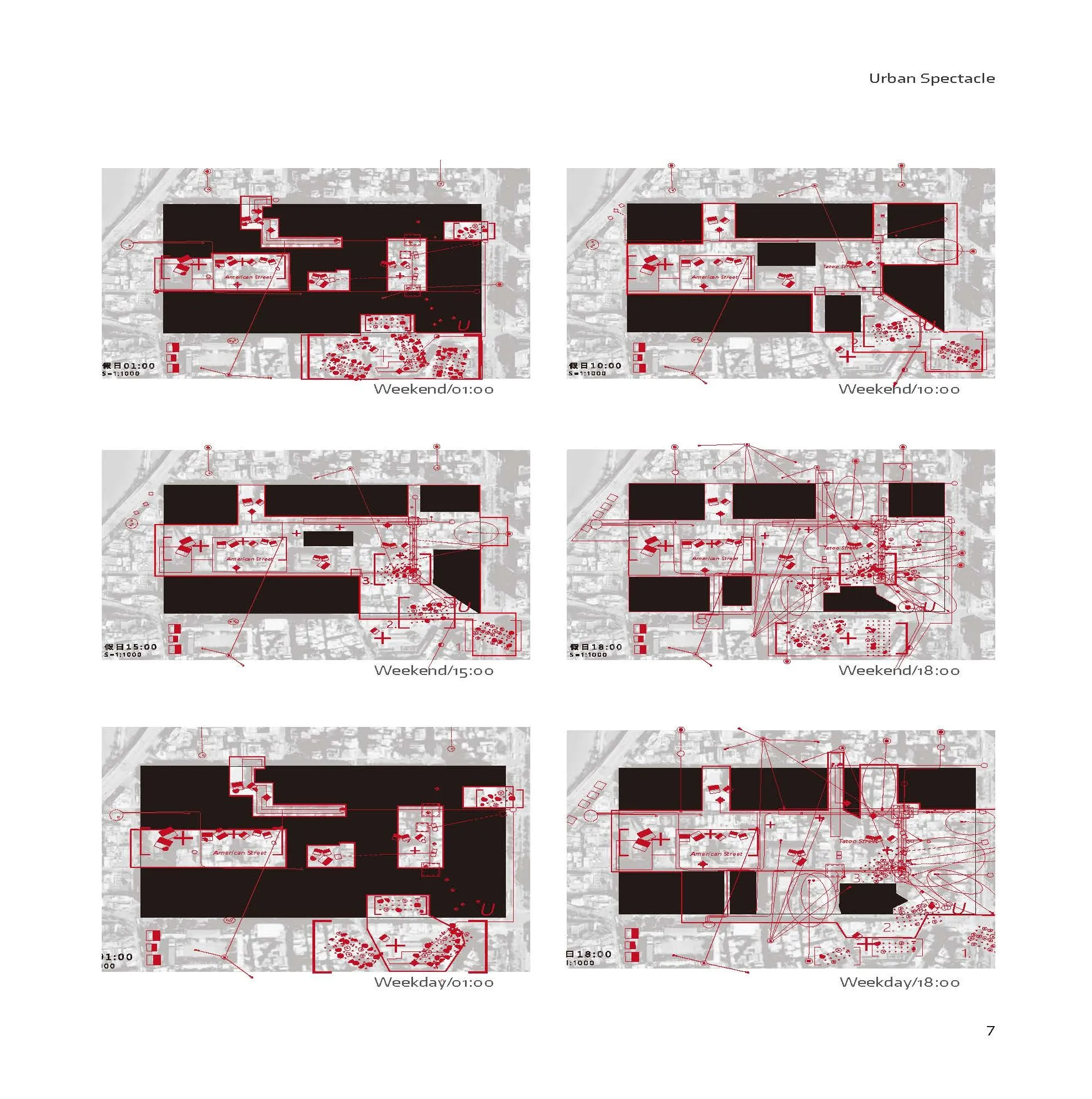
Erase/ Origin/ Transformation/ Migration
By utilizing four keywords from Raoul Bunschoten’s Metaspaces (1998)—erasure, origination,transformation, and migration—it is possible to shift the framing of dynamic urban operations into a smaller, localized focus. These simplified, tangible urban events form a continuous relationship,transforming what was once an intangible urban condition into a concrete, interpretable miniscenario,laying the foundation for constructing an urban model.
Each of the four keywords represents a critical moment within the system, capturing independent events with distinct characters, circumstances,time, and space. The causal relationships between them connect these events, turning them into a network of interconnected nodes. This network creates a context with nexuses, allowing one to shift from one thread to another.
The four keywords also mirror the traditional Chinese narrative structure of “qi, cheng, zhuan, he”( 起、承、轉、合), akin to a quatrain in poetry.Each line represents the beginning, development,change, and conclusion, forming a universal narrative style applicable across different contexts.
Through the collection of “mini-scenarios,” or interconnected anchoring points, a large-scale urban model gradually emerges from fragmented pieces. What was once an intangible dynamic city becomes a concrete, traceable structure, capable of mutation and enabling the simulation and prediction of future urban developments.
Alternative
A. Street Vendors in the Prime Zone aE1 / Vendors occupy voids between columns. aO1 / They wander in search of fixed points. aT1 / Their gatherings form the busiest area. aM1 / Crowds migrate toward bustling zones. B. Aristocratic Tourists aE1 / Tourists erase public seating spaces. aO1 / They occupy double seats individually. aT1 / Public seating is used extravagantly. aM1 / Poorer residents leave for living spaces. C. Wandering Misreaders aE1 / Residents use stair spaces to rest. aO1 / They misread spaces in search of shelter. aT1 / Traffic islands and streetlamps become resting spots. aM1/ Homeless move to Ximending’s outskirts. D. Urban Marginals aE1 / Homeless occupy open spaces outside stores. aO1 / They measure spaces with their bodies to find shelter. aT1 / Cardboard create makeshift fortresses. aM1 / Various social group create dynamic trends. E. Alice in Dreams A Watsons building, once remembered, is now replaced by unfamiliar waterproof tarps. F. Monet’s Little Shop Street performers occupy spaces between tree pits in the pedestrian zone.

Ecology
A.Living / Non-Living eE2 /Cardboard boxes and signs occupy Ximending’s street Ximending’s streets. eO2 /Recycling grandmothers and trucks join the ecosystem. eT2 /Cardboard and signs are repurposed. eM2 /New values and uses emerge. B.Tom & Jerry eE3 /Street carts and police cars chase each other. eO3 /Street carts suffer damages from constant movement. eT3 /Carts are repaired on hardware street. eM3 /They return to Ximending to resume the chase. C.New Paradise eE1 /Embankments erase Ximending’s connection to the Tamsui River. eO1 /Embankments protect Ximending. eT1 /The outside becomes a leisure space. eM1 /People migrate to the green space on holidays. D.Advertising Ecosystem Signs showcase subcultures, attracting crowds to sustain life amid homogenized facades. E.Homeless and Tourists Homeless and tourist coexist,dividing Ximending into two realms. F.Recycling Center On a Tamsui River island, billboards form houses where discarded signs are reborn.
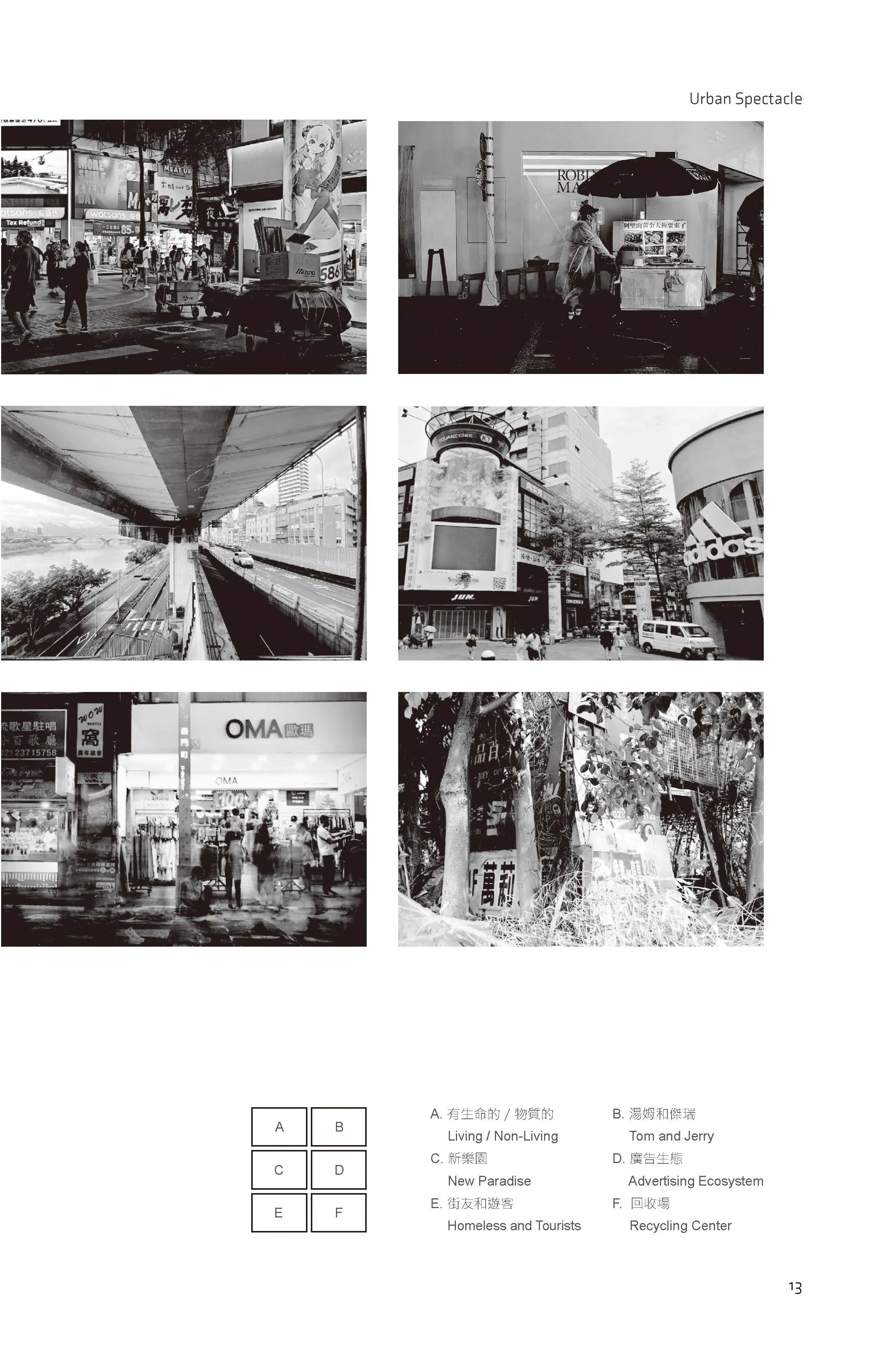
Cuisine
A. Diversity in Dining cE3 /Tourists dine at Taiwanese-themed restaurants. cO3 /Unsatisfied tourists seek street snacks. cT3 /The crowd outside the old shop draws tourists. cM3 /Tourists follow the crowd to the old shop. B. A Day of Street Carts cE2 /The warehouse for illegal carts is hidden. cO2 /Street carts appear in Ximending. cT2 /The focus shifts to enforcers. cM2 /Street carts move to alleys. C. Ximending Dining History (1949-2024) cE1 /Political changes erase culture. cO1 /New culture takes root. cT1 /New culture becomes Ximending’s symbol. cM1 /History attracts chain stores. D. Laoshandong Beef Noodles Founded in 1949, with clear broth, homemade noodles, and Taiwanese-Australian beef. E. Meiguan Garden Founded in 1946, moved across the street. Sushi with secret sauce and extra fish slices. F. Street Cart Equipment Street carts store gas, dish soap, umbrellas, paper bags, and batteries. Vendors prepare ingredients and cook at the cart.

Belief
A. Mechanism of Belief Formation bE0 / People erase connections with reality. bO0 / They appear in new forms. bT0 / Homogeneity turns individuals into a group. bM0 / Believers migrate to specific places. B. Non-Mainstream Trends bE1 / Ximending erases traditional restrictions. bO1 / Homosexuals begin gathering in Ximending. bT1 / Ximending declined, and the gathering shift. bM1 / After the Red House is rebuilt, the LGBTQ+ community returns to Ximending. C. Marginal Zones bE2 / Legal limits erase graffiti artists from view. bO2 / Graffiti appears in corners to express beliefs bT2 / Graffiti zones are designed,legitimizing the art. bM2/ Graffiti artists migrate to legal areas. D. Meeting Across Distance bE3 / Vtuber masks erase real faces. bO3 / Meet-and-greet announcements draw crowds to the plaza. bT3 / Sakura Miko’s sudden screen appearance shifts focus and expectations. bM3 / Fans gather, while others leave. E. Maria’s Wall Graffiti appears where fai th influence blurs but cannot reach the church facade. F. Hidden Locations Graffiti’s hidden spots are marked on official maps
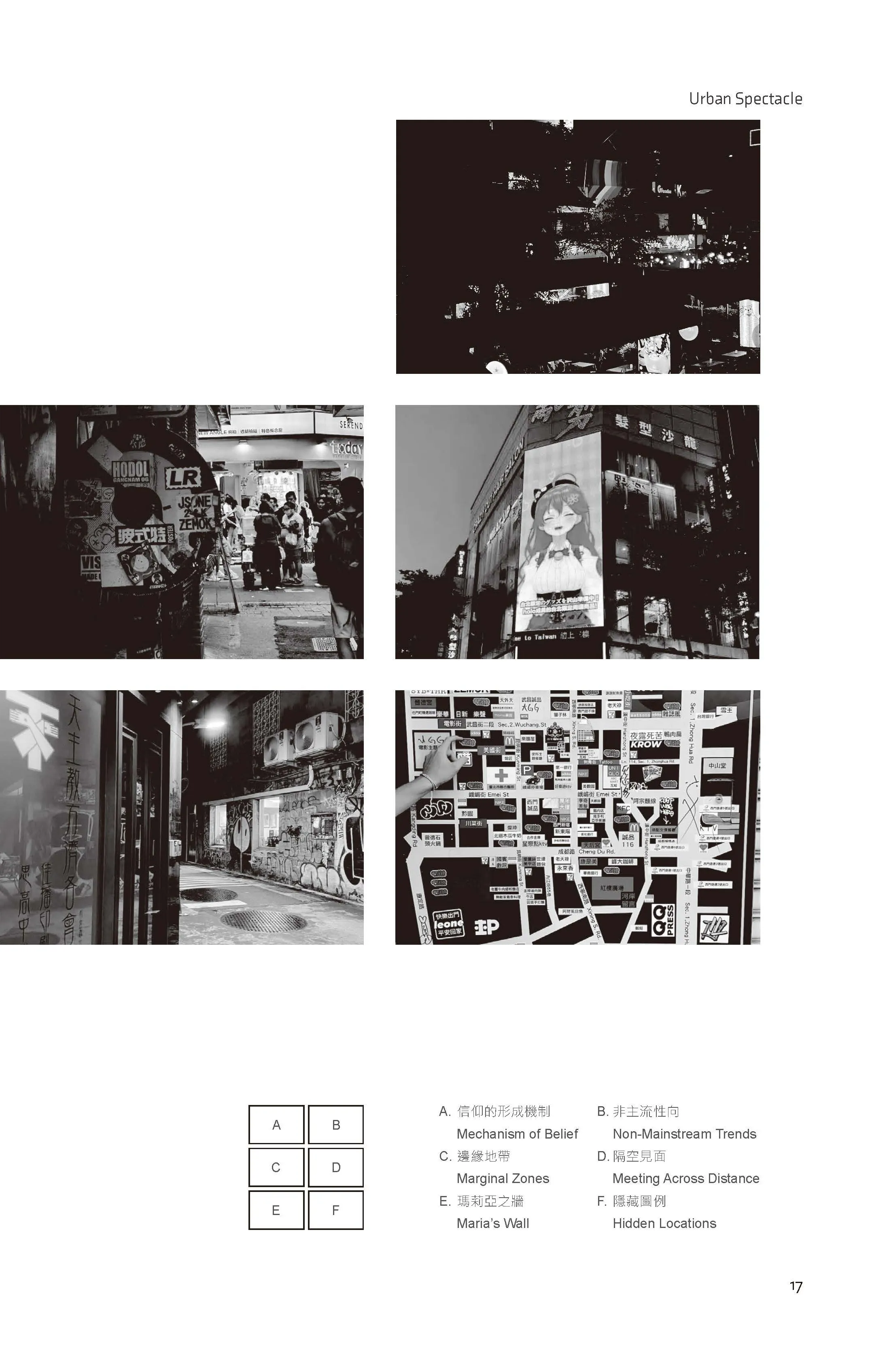
Recreation
A. Self - Role Player rE1 / Change into the character’s outfit at home. rO1 / People begin to approach me. rT1 / I become the character. rM1 / Take photos in various role-playing scenarios. B. Framework - Photographer rE2 / Enter a thematic box, disconnect from reality. rO2 / The camera counts down, transitioning to a virtual state. rT2 / As photos accumulate, people enter the scene. rM2 / Countdown ends, returning to reality. C. Framework - Viewer rE2 / Enter a black space, erase societal norms. rO2 / The movie starts. rT2 / My emotions shift with the movie’s plot. rM2 / Lights on, returning to reality. D. Private - Stress Reliever rE4 / Store closes its door, cutting off outside noise. rO4 / Change into massage clothes, begin the massage. rT4 / I relax and let the therapist work. rM4 / The session ends, returning to the outside. E. Self - Homosexual Ximen offers acceptance place, providing a sense of security with like-minded people. F. Private - Addict Water pipes and bars offer an escape from reality into a drunken world.
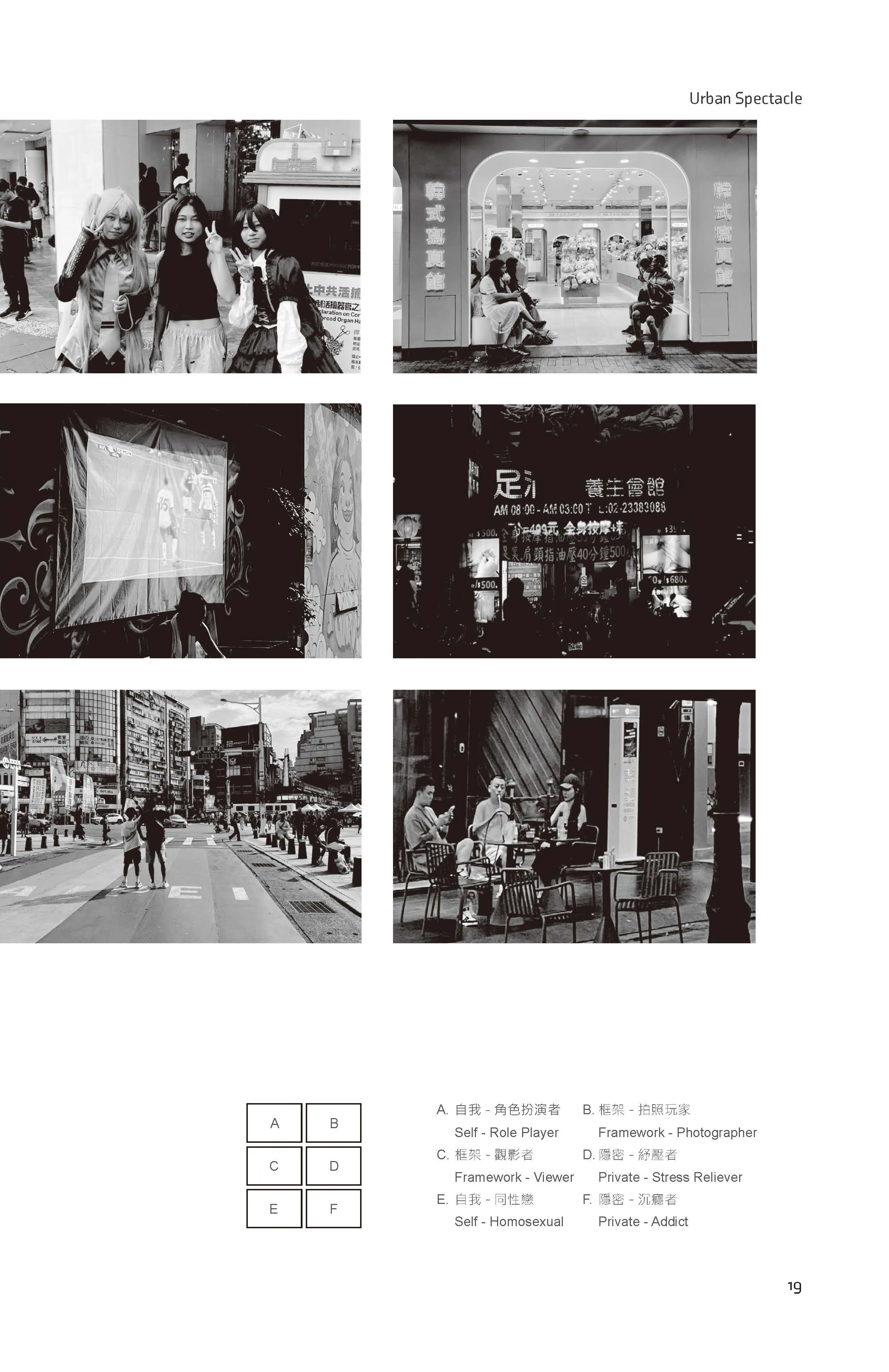
Cross-Group EOTM
Recreation/Belief/Cousine
rbE4 Cosplayer wipes away their usual attire. rbO4 Cosplayer board the subway,and the group begins to take shape as they become recognizable through their costumes. rbT4 Cosplayer arrives in Ximending and heads to a custom costume shop, transforming into their more ideal s elf. rbM4 Characters migrate to specific locations, forming gatherings. crbE3 Homosexuals enter the bar, isolating themselves from the outside world. crbO3 As the number of similar individuals increases,others begin to leave. crbT3 Homosexuals transform into their truest selves. crbM3 After the joy ends, they return to their societal roles.

Cousine/Ecology/Belief/Alternative
cebE2
Graffiti erases the original information carried by the signage.
cebO2
Graffitied, abandoned signage is taken by recyclers to the hardware street.
cebT2
Signage that once carried information is transformed into construction materials.
cebM2
The construction materials are repurposed as stall structures and migrate back to Ximending.
caE1
New buildings erase the original settlements.
caO1
Buildings begin to create orderly layouts.
caT1
Street vendors reinterpret arcades as selling spaces.
caM1
Crowds migrate here to consume.
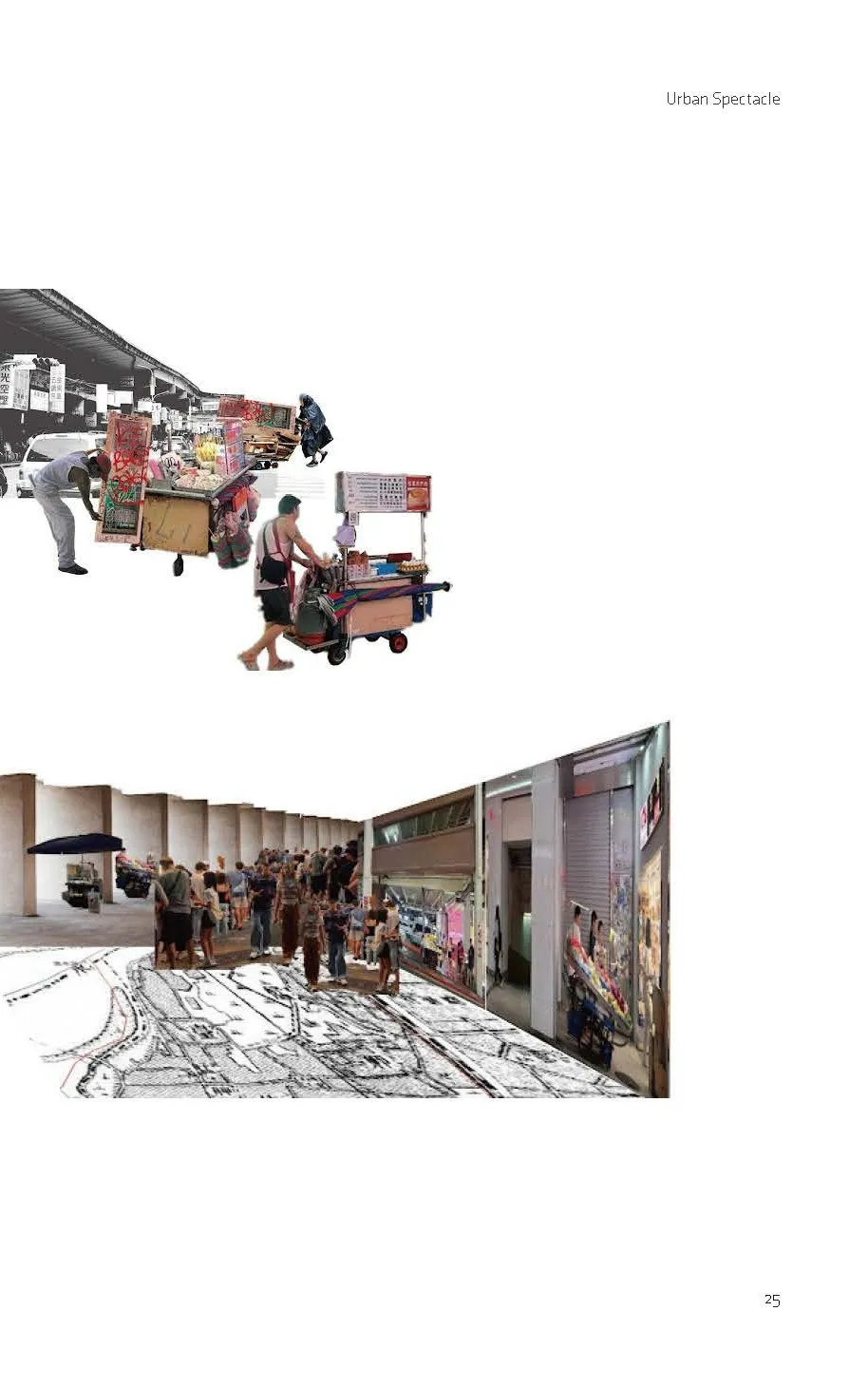
Horizontal Line
At this stage, discussions on each theme unfold along a horizontal line.
Alternative/
At the boundary, space is excavated along the line.As the boundary becomes a void, it generates two new boundaries. This iterative process approaches emptiness while retaining the boundary’s nature.
Ecology/
The ecology is revealed by organizing its activities and object systems. A vertical height interval combines living beings and objects, highlighting value transformations as they cross the line.
Cuisine/
This picture indicates local vendors, and foreign cuisines from top to bottom. Key events include the 1949 migration of KMT and the rise of chain restaurants in the 1980s.
Belief/
The sectional line marks where beliefs manifest,shaped by group movements and gatherings.This line’s position and timing are fluid, reflecting collective dynamics.
Recreation/
The horizontal line marks the boundary to the virtual world. Different roles form a banded space based on their immersion in alternate worlds,blending reality and virtuality into a “paradise”.

Common Horizon
Based on the element extraction of Ximending,we organize a common horizon and look for descriptions of the “horizon” from five major categories: Alternative, Ecology, Cuisine, Belief,and Recreation. The misreading and occupation of urban space (animal collages), the flow and value transformation of objects (combinations of dense and sparse lines), the historical rise and fall of restaurants and the constant presence of street vendors (horizontal dashed lines), the gathering of believers and patterns of faith manifestation (circles), and the temporary pleasure that detaches from the real world (vertical connected lines).
These elements collectively aggregate and describe an imagined boundary of Ximending, revealing a segment that is relatively clean and distinct from the complex sides.
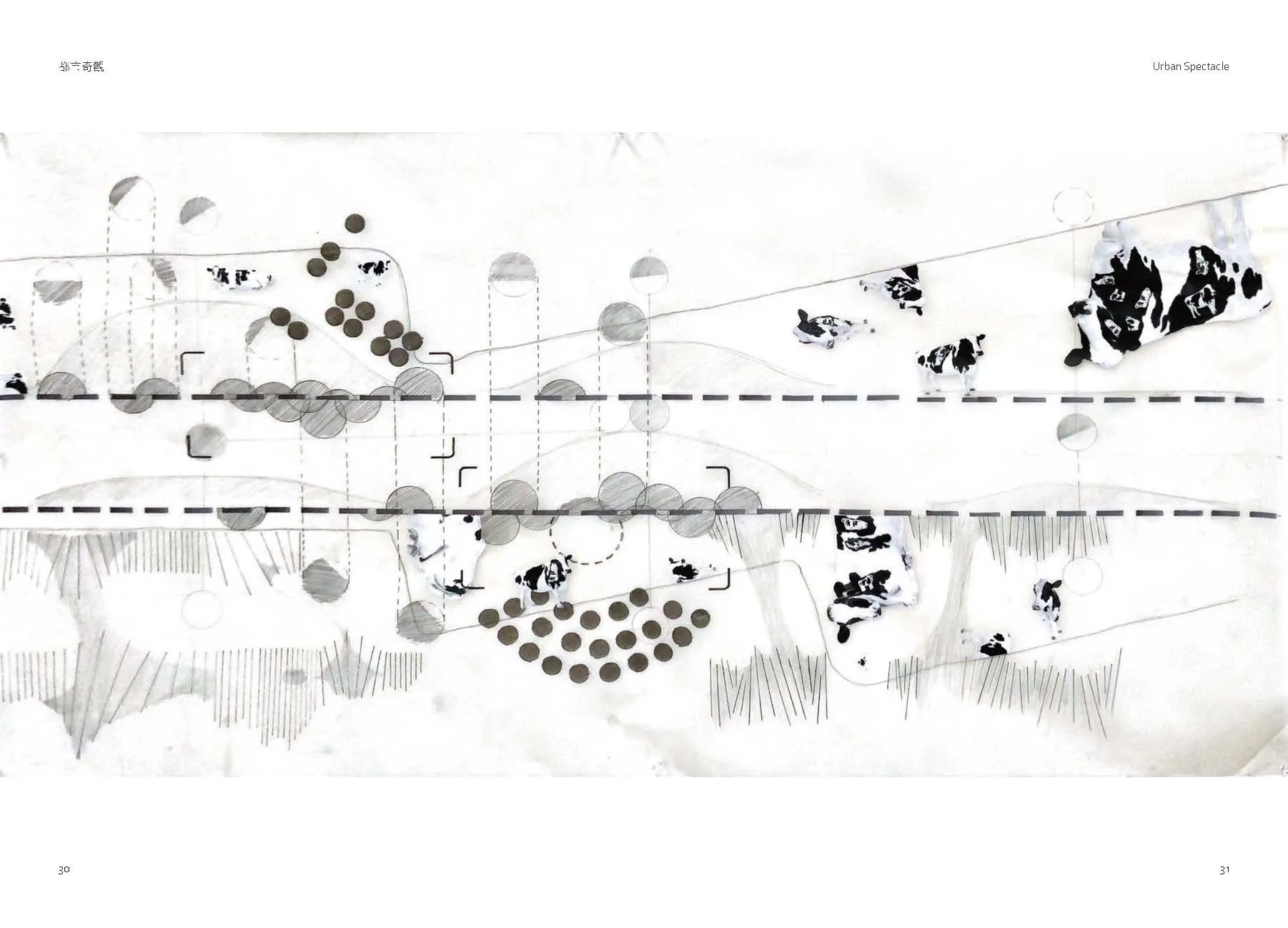
Time Horizon
We consolidated the horizontal planes from each group into a collective imagining of Ximending,linking the events observed by each group in Ximending to new horizontal dimensions of area.
From early weekday at 10 a.m. to 6 p.m. to 1 a.m.,and on weekends from 10 a.m., 3 p.m., 7 p.m.,midnight, and back to 1 a.m., distinct phenomena unfold. For instance, during weekday late nights,perspectives like Cuisine, Recreation, and Belief intersect, as seen in the dynamics of LGBTQ+individuals entering bars, isolating themselves from the external world. With an increasing number of similar individuals, those who differ gradually leave, allowing LGBTQ+ individuals to express their truest selves. However, this transformation dissipates after the night’s revelry, as they return to their societal roles—an occurrence specific to nighttime hours. These distinct activities only emerge at particular times, leading to a redefinition of Ximending’s boundaries. The originally mapped,“official” boundaries of Ximending are altered by subjective perceptions, resulting in a collectively redefined understanding of Ximending’s borders.

1:1 Operation Overview
Layered Conjonction
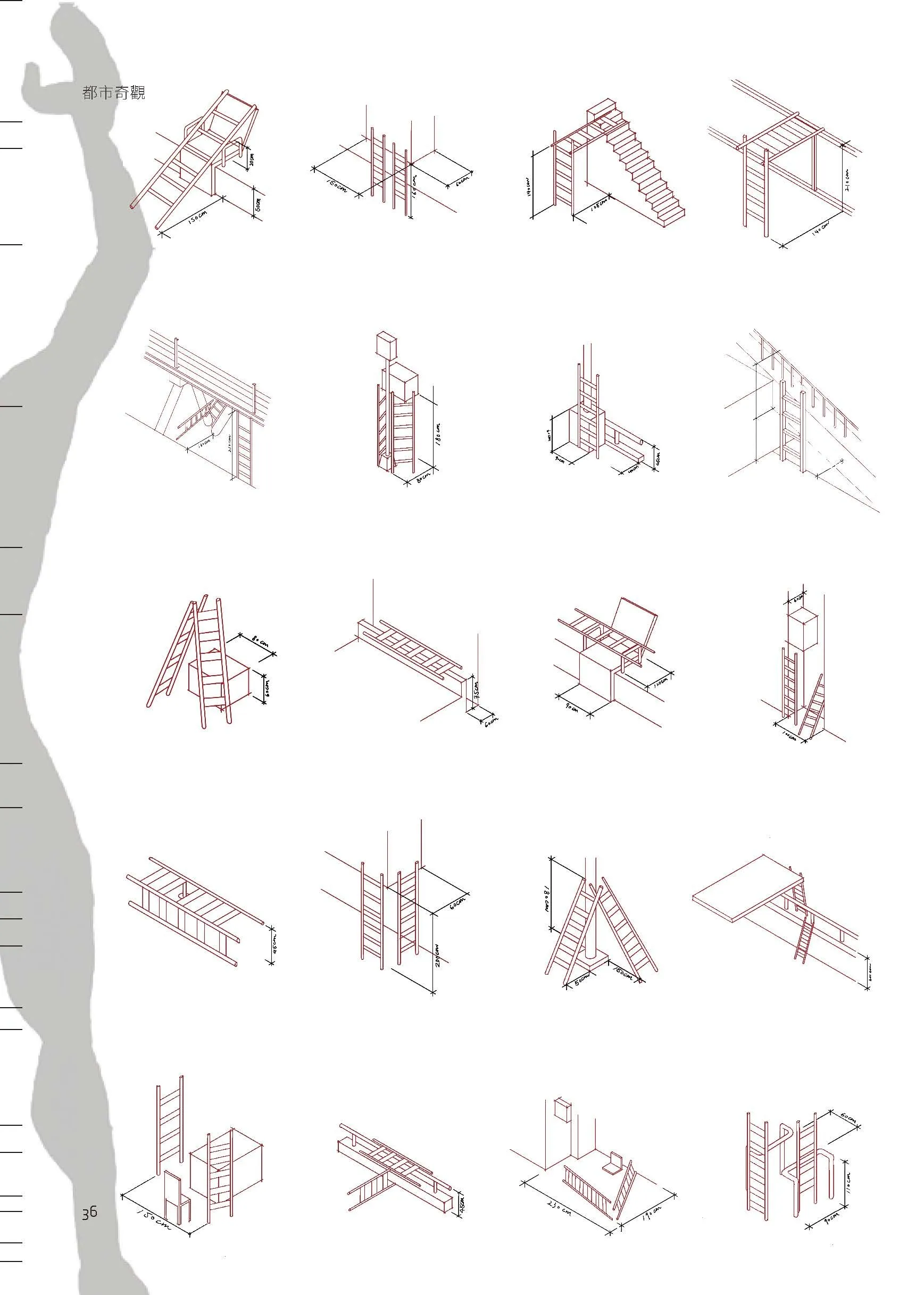
During the 1:1 trans-aparatus phase, we documented ten types of utilizations at different heights and envisioned forty possibilities for street spaces in Ximending. The height-based observations included a variety of spaces or mobile devices. These were categorized based on interactions with people or between objects.Meanwhile, the forty street space imaginings focused on recording spaces that we believed could integrate with the devices and be reinterpreted.
Simultaneously, we used devices to rebuild and reshape these spaces, assigning them new spatial identities. Through this process of spatial translation, familiar spatial functions began to adopt new dimensions, and various locations acquired functions not originally belonging to them. Examples include a street shower stall, a restroom beneath an air conditioner, or a small awning extending from a transformer box that offers a place to rest.
At this stage, we experimented with new spatial scales and the collision of different functions and forms to generate new rules and possibilities.
Linear Buffur
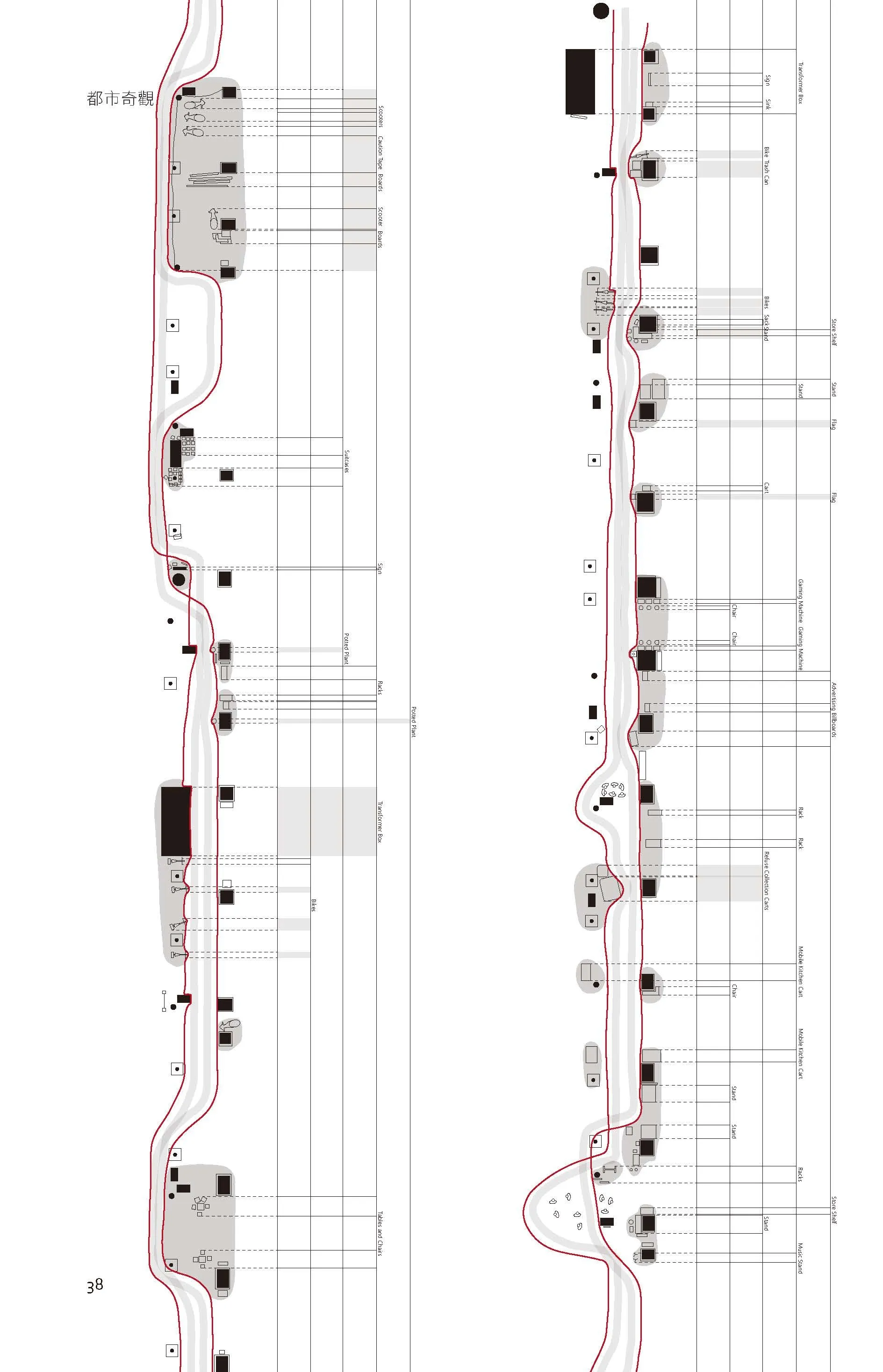
Using devices (figure1.) made of flexible plastic panels (represented by red curves) and rigid wooden frames (represented by gray curves),we conducted repeated measurements and recordings along the unique spaces in Ximending’s pedestrian zone. These spaces are defined on one side by arcade columns and on the other by public infrastructure such as streetlights, trees, trash bins,and benches (depicted as black blocks), forming a layered linear buffer with spatial depth.
These government-planned public structures serve as containers for informal activities within Ximending’s pedestrian zone. Objects and individuals interact with the linear buffer by occupying shaded corners or layering over public structures.
Through the relationship between the red curves and light red bubbles, we can observe how existing infrastructures and the temporarily stationed objects or people form groupings. This dynamic interaction shapes the spatial expansion,compression, and coordination within the linear buffer, transforming it into an essential yet often overlooked public space in Ximending.
Dynamic Exchange
“Materials transform their properties over time,seeking belonging in the shifting urban landscape.Yet in Ximen, rapid urban development compresses and releases time, making conventional notions of time and transformation unreadable. Without time as a guiding force, how materials change in Ximen?
Through 1:1 installation sampling, we found that material transformation in Ximending is driven by exchange rather than time. Exchange fulfills the diverse material needs of urban groups and serves as a mechanism for transformation. For instance,cardboard boxes used by shops for transporting goods hold a different value for the homeless, who exchange them for monetary compensation.”

Release Edge
This project studies the movement paths and activity spaces of subcultural groups in Ximending.The research shows that these groups utilize marginal and neglected spaces in the city for identity transformation and activities. Positive spaces refer to public, noticeable urban centers, while Negative spaces are overlooked peripheral areas.
The installation measures bodily extension in urban spaces (public/private, positive/negative space).
It can be folded and unfolded to varying extents,integrating with the sites and crowds, identifying critical points between positive and negative spaces and assessing how the body is regulated or liberated in urban space.
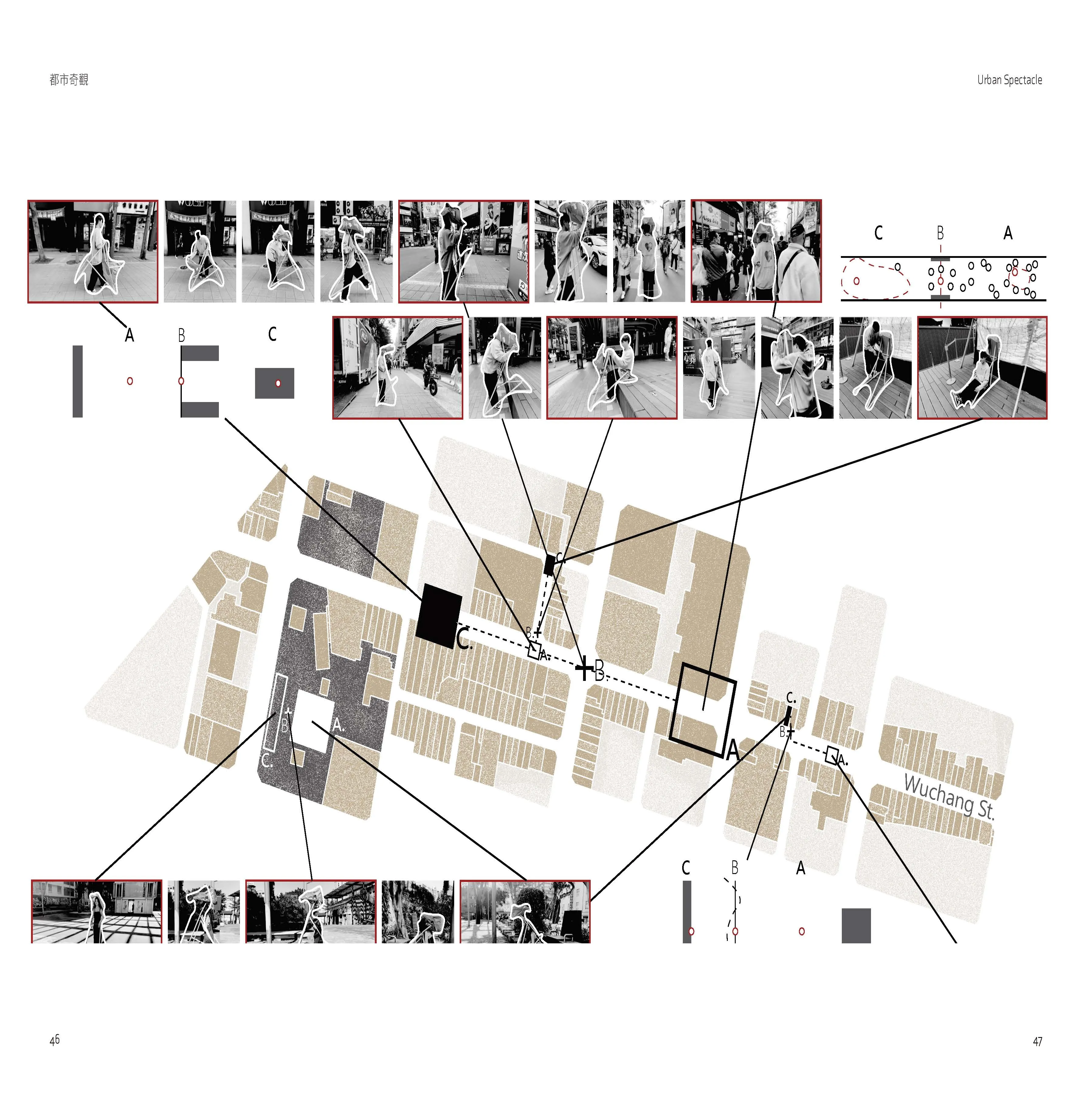
Release Edge

Starting from Ximending’s entertainment activities,the 1:1 installation uses a modified cart to create a movable camera tripod and a space-recording container, corresponding to human body scales like standing, sitting, and proximity to the ground. The camera captures the evolving relationship between people, time, and the environment, forming containers with varying voids, and creating distinct spatial atmospheres.
The installation documents profiles and timerelated changes across Ximending, from Taipei Island to the Movie Park, Disease Prevention Center, pedestrian zone, and the Red House. Each photo records shifting activities and environments,turning them into containers that carry the atmosphere of the space. This mirrors how the pedestrian zone is shaped by stores, creating porous spaces with different lighting, and how the installation reflects voids formed by heights.
Returning to the installation, it serves as a container for the body’s spatial expression, while the camera captures the state and dynamics of a space in a given moment. This mirrors how people move between timeless commercial spaces and time-bound pedestrian zones, reflecting how consumerism creates endless timeless containers that encourage consumption.
Urban Spectacle
Like a flaneur mentioned by Walter Benjamin, we drifted along the Taiwanese arcade in Ximendin to explore the highly mixed city district made of historical, contemporary, commercial and residential elements, where Its détournement away from the official government regulation makes spectacular bottom-up management and creates an “Urban Spectacle”, an agglomeration of premodernism,modernism and postmodernism.


